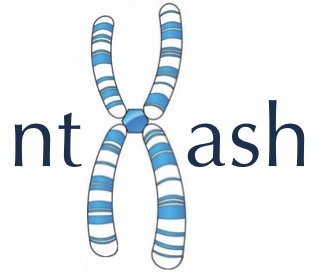ntHash is a recursive hash function for hashing all possible k-mers in a DNA/RNA sequence.
Download the repo and generate a cmake buildsystem in an arbitrary directory (e.g. release), by running the following command in the project's root:
cmake -S . -B releaseThen, build the project and its dependencies using:
cmake --build release --target allThe project's executable (./nthash), static library (libnthash.a), and tests (nthash_tests) will be generated alongside btllib in the release folder.
Tests can be run using ctest:
cd release && ctestAfter building the project, use the output binary file to generate hash values from input data and store the results on disk:
Usage: nthash [options] files
Positional arguments:
files Input sequence files [required]
Optional arguments:
-v --version prints version information and exits [default: false]
-k k-mer size [required]
-o Output file (for -f collect) or directory path [required]
-f Output file organization (create files containing hashes for each 'file', 'record', or 'collect' all hashes into a single file [default: "file"]
-h Number of hashes per k-mer [default: 1]
-s Input spaced seed patterns separated by commas (e.g. 1110111,11011011). Performs k-mer hashing if no value provided.
--long Optimize file reader for long sequences (>5kbp) [default: false]
--binary Output hashes in binary files (otherwise plain text) [default: false]
--verbose Print progress to stdout [default: false]
For example, given two input files 1.fa and 2.fa, two hash values for each 64-mer can be saved to a binary file called out.bin by running this command in release:
./nthash -k 64 -h 2 -o out.bin -f collect --binary --verbose 1.fa 2.faIn the plain text format (tab separated values), the rows consist of the hashes of k-mers/seeds in the same order seen in the input sequences. For binary output, these values are dumped without any delimiters. E.g. in the case of out.bin generated above, the first and second hashes of the first k-mer are stored in the beginning of the file, followed by the first and second hashes of the second k-mer.
To use ntHash in a C++ project:
- Link the code with
libnthash.a(i.e. pass-L path/to/nthash/release -l nthashto the compiler). - Add the
includedirectory (pass-I path/to/nthash/includeto the compiler). - Repeat for btllib (add flags:
-L path/to/nthash/release/btllib -l btllib -I path/to/nthash/vendor/btllib/include) - Import ntHash in the code using
#include <nthash/nthash.hpp>. - Access ntHash classes from the
nthashnamespace.
Generally, the nthash::NtHash and nthash::SeedNtHash classes are used for hashing sequences:
nthash::NtHash nth("TGACTGATCGAGTCGTACTAG", 1, 5); // 1 hash per 5-mer
while (nth.roll()) {
// use nth.hashes() for canonical hashes
// nth.get_forward_hash() for forward strand hashes
// nth.get_reverse_hash() for reverse strand hashes
}std::vector<std::string> seeds = {"10001", "11011"};
nthash::SeedNtHash nth("TGACTGATCGAGTCGTACTAG", seeds, 3, 5);
while (nth.roll()) {
// nth.hashes()[0] = "T###T"'s first hash
// nth.hashes()[1] = "T###T"'s second hash
// nth.hashes()[2] = "T###T"'s third hash
// nth.hashes()[3] = "TG#CT"'s first hash
}Refer to docs for more information.
Parham Kazemi, Johnathan Wong, Vladimir Nikolić, Hamid Mohamadi, René L Warren, Inanç Birol, ntHash2: recursive spaced seed hashing for nucleotide sequences, Bioinformatics, 2022;, btac564, https://doi.org/10.1093/bioinformatics/btac564
Hamid Mohamadi, Justin Chu, Benjamin P Vandervalk, and Inanc Birol. ntHash: recursive nucleotide hashing. Bioinformatics (2016) 32 (22): 3492-3494. doi:10.1093/bioinformatics/btw397
- ntHash: Hamid Mohamadi
- ntHash2: Parham Kazemi
- btllib: Vladimir Nikolic
- argparse for C++



